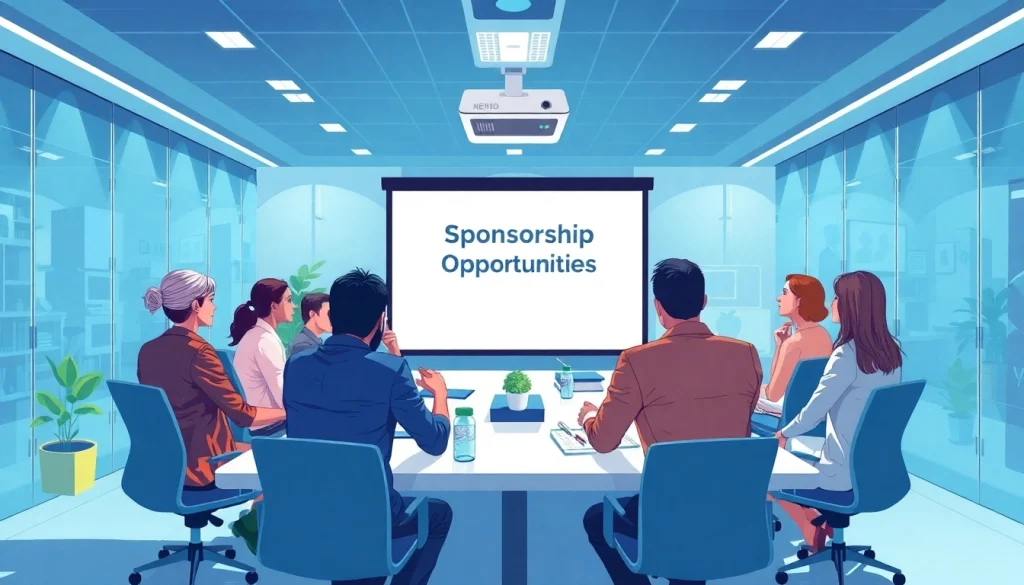
Understanding Sponsorship Opportunities
Sponsorship opportunities provide a unique way for businesses, nonprofits, and events to form mutually beneficial partnerships. By aligning with sponsors, organizations can enhance their brand visibility and reach new audiences, while sponsors gain the chance to promote their products or services in front of targeted groups. For those seeking such partnerships, it is critical to navigate this landscape effectively to maximize potential benefits. In this guide, we will explore the different facets of sponsorship opportunities, equipping you with the knowledge to secure and optimize these arrangements.
What Are Sponsorship Opportunities?
Sponsorship opportunities refer to the agreements where one party (the sponsor) provides support—often financial in nature—to another party (the sponsee) in exchange for marketing benefits and promotional visibility. These arrangements can be made for events, programs, or projects and can include various forms of support such as monetary funding, products, or services. The primary goal for sponsors is typically to enhance brand recognition and reach a specific demographic aligned with their marketing objectives.
Types of Sponsorship Opportunities Available
Different types of sponsorship opportunities exist, each catering to various needs and interests:
- Event Sponsorship: Companies often sponsor conferences, sports events, or cultural festivities to gain visibility. Examples include sponsoring a marathon or a festival.
- Program Sponsorship: Organizations may align with educational or community programs, providing financial support in exchange for branding opportunities.
- Media Sponsorship: This involves sponsoring a media outlet or content series, leading to shared promotional activities.
- Cause-Related Sponsorship: Brands partner with nonprofits or social causes to enhance their public image while contributing to a good cause.
- Influencer Sponsorship: Brands collaborate with social media influencers to promote their products or services, capitalizing on the influencer’s audience.
Benefits of Engaging in Sponsorship
Engaging in sponsorship opportunities can yield a plethora of benefits:
- Increased Brand Awareness: Sponsorship can significantly amplify a brand’s visibility, allowing it to reach new customers.
- Enhanced Credibility: Associating with respected events or organizations can enhance a brand’s reputation and credibility.
- Networking Opportunities: Sponsoring events allows for direct interaction with potential clients and other industry professionals.
- Targeted Marketing: Sponsorship provides a platform for companies to reach specific demographic groups in an engaged setting.
- Improved Business Relationships: Through sponsorship, businesses can deepen relationships with existing customers and cultivate new connections.
How to Identify Potential Sponsors
Researching Sponsorship Opportunities
The first step in identifying potential sponsors is to conduct thorough research. This involves interviewing various stakeholders, analyzing market trends, and evaluating the sponsorship landscape in your industry. Start by defining the objectives and audience of your project or event. Then, look for companies whose target market aligns with your audience. Resources such as industry reports, competitor analysis, and sponsorship directories can provide insights into companies actively seeking sponsorship opportunities.
Key Considerations for Finding Sponsors
When looking for potential sponsors, consider the following:
- Brand Alignment: Ensure that the potential sponsor’s brand values and mission align with yours.
- Target Audience: Verify that the sponsor’s audience matches the demographic you aim to reach.
- Budget Considerations: Understand the potential sponsor’s budget for partnerships, as this can influence the level of support they can provide.
- Previous Sponsorship Experience: Research whether they have a history of sponsorship and what the outcomes were.
Using Networking to Discover Opportunities
Networking plays a crucial role in uncovering potential sponsorships. Attend industry events, seminars, and workshops where you can meet representatives from prospective companies. Utilize platforms like LinkedIn to connect with decision-makers in organizations that align with your mission. Engaging directly with individuals in your industry can lead to fruitful conversations about potential sponsorships.
Crafting Your Sponsorship Proposal
Essential Elements of a Winning Proposal
A well-structured sponsorship proposal can greatly enhance your chances of securing a partnership. Here are the essential elements you should include:
- Introduction: Provide a brief overview of your organization and the opportunity at hand.
- Objectives: Clearly outline the goals of your event or project and how the sponsor fits into it.
- Audience Insights: Include demographic information about your target audience to showcase the potential reach for the sponsor.
- Benefits: Specify what the sponsor will gain from the partnership, such as logo placement, media exposure, etc.
- Call to Action: Encourage the potential sponsor to take the next steps in the proposal.
Tailoring Your Pitch for Different Sponsors
It’s crucial to personalize your proposal to each potential sponsor. Research their previous sponsorship activities and tailor your pitch to align with their objectives. For example, if a company previously sponsored environmental initiatives, highlight how your project promotes sustainability and can enhance their brand image within that space.
Best Practices for Proposal Presentation
The way you present your proposal can be just as important as the content itself. Here are some best practices:
- Professional Design: Use visually appealing layouts and formats to enhance readability.
- Concise and Clear Language: Avoid jargon and keep your language straightforward to ensure clarity.
- Use Visuals: Incorporate charts, graphs, and images to illustrate impact and potential returns for the sponsor.
- Follow Up: After sending out your proposal, ensure to follow up to show your eagerness and maintain communication.
Maximizing the Impact of Sponsorships
Building Long-term Relationships with Sponsors
Once a sponsorship is established, the focus should shift to nurturing the relationship. Regular communication, transparency regarding progress, and reporting on outcomes are key to maintaining a healthy partnership. Engage your sponsors through updates, invitations to events, and appreciation gestures to reinforce the relationship.
Measuring Success in Sponsorship Engagements
Measuring the effectiveness of sponsorships is crucial for understanding ROI and improving future proposals. Implement metrics such as:
- Brand Visibility: Track exposure through impressions, mentions, and shares on various platforms.
- Audience Engagement: Measure audience interactions and feedback related to the sponsorship.
- Sales Data: Compare sales performance during and after the sponsorship period.
- Post-Event Surveys: Utilize surveys to gather feedback from both attendees and sponsors about the experience.
Case Studies: Successful Sponsorship Examples
Learning from successful case studies can provide valuable insights into effective sponsorship strategies. For instance, a well-known example is the partnership between Red Bull and extreme sports. Red Bull has successfully created a brand synonymous with adventure and excitement through a strategic sponsorship approach that aligns with its identity.
Navigating Challenges in Sponsorship Opportunities
Common Pitfalls and How to Avoid Them
While sponsorships offer numerous benefits, recognizing and addressing common pitfalls is vital. These may include misaligned goals, inadequate communication, and failure to meet sponsor expectations. To avoid these, ensure all parties have clear objectives and agree on deliverables from the outset.
Adapting to Market Changes in Sponsorship
The market for sponsorships is dynamic and can shift due to economic conditions, consumer behavior changes, or emerging trends. Stay informed about industry trends and adapt your strategies accordingly. Flexibility in your approach can help maintain relevance in sponsorship discussions.
Utilizing Feedback for Continuous Improvement
Feedback from both sponsors and participants should be analyzed post-sponsorship to identify strengths and areas for improvement. Creating a learning loop can facilitate better proposals and partnership experiences in the future. Implementing constructive feedback is essential to refining your sponsorship strategy over time.






